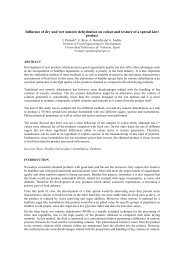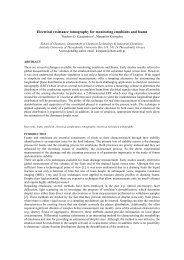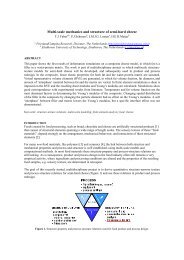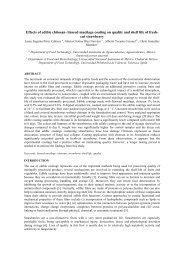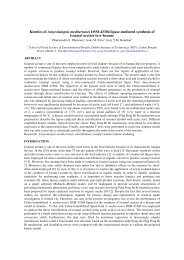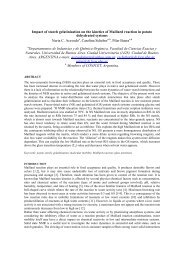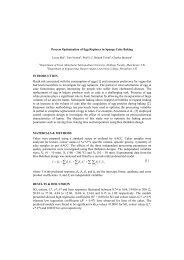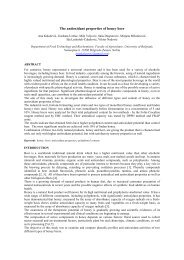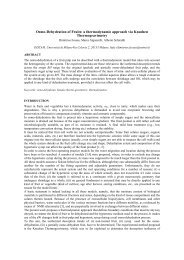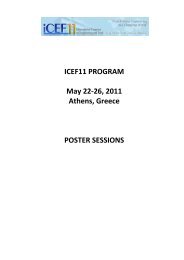Generalized convection and power-law models to represent ... - USP
Generalized convection and power-law models to represent ... - USP
Generalized convection and power-law models to represent ... - USP
Create successful ePaper yourself
Turn your PDF publications into a flip-book with our unique Google optimized e-Paper software.
The best model fit was obtained with the combined PFR+CSTR model, whose parameters are presented in<br />
Figure 4c. For laminar flow, parameter plug is actually the breakthrough time associated with the maximum<br />
velocity at the centre of the tube. The difference between the <strong>convection</strong> <strong>and</strong> combined <strong>models</strong> resides on the<br />
shape of the descending part or the curve. As can be noticed in Figure 2, the <strong>convection</strong> model better<br />
<strong>represent</strong>ed this part of the curve.<br />
The difference between the theoretical residence time <strong>and</strong> the residence time predicted by the combined<br />
model can be seen in Figure 4d. This difference suggests that 19% of the internal volume of the exchanger is<br />
associated with stagnation <strong>and</strong> recirculation regions.<br />
Figure 5 brings the theoretical E-curve <strong>and</strong> the predictions from the adjusted RTD <strong>models</strong> for laminar flow in<br />
the double-pipe heat exchanger with a flow rate of 15 L/h. It is clear that the proposed <strong>models</strong> could capture<br />
the nonideality of the flow. The combined model provided the best fit, but the difference among the model<br />
curves in Figure 5 is rather small. The curves in Figure 5 could be combined with the temperature<br />
distribution along the exchanger in order <strong>to</strong> evaluate the distributed <strong>and</strong> integrated lethality in the heating<br />
section of the exchanger [11].<br />
CONCLUSIONS<br />
The proposed <strong>models</strong> proved <strong>to</strong> be useful <strong>to</strong> <strong>represent</strong> RTD of non-laminar flow in tubular systems, which<br />
are usually found in the continuous processing of liquid foods. The E-curve of these <strong>models</strong> can <strong>represent</strong> the<br />
tail of tracer that is inherent in laminar flow. These <strong>models</strong> can be used in practice <strong>to</strong> <strong>represent</strong> the flow<br />
patterns of tubular vessels <strong>and</strong> <strong>to</strong> diagnose deviations from non-ideal flow. Future testes will be conducted<br />
using a glycerol/water mixture, which is a New<strong>to</strong>nian viscous liquid, <strong>and</strong> a CMC solution, which is a pseudoplastic<br />
viscous fluid.<br />
ACKNOWLEDGMENTS<br />
The authors wish <strong>to</strong> thank the São Paulo State Research Fund Agency (FAPESP 2009/07934-3) <strong>and</strong> the<br />
National Council for Scientific <strong>and</strong> Technological Development (CNPq PIBIC) for financial support.<br />
REFERENCES<br />
[1] Toledo R.T. 1999. Fundamentals of Food Process Engineering. 2.ed. New York: Chapman & Hall.<br />
[2] Lewis M. & Heppell N. 2000. Continuous Thermal Processing of Foods: Pasteurization <strong>and</strong> UHT Sterilization. Aspen<br />
Publishers, Gaithersburg, USA.<br />
[3] Torres A.P. & Oliveira F.A.R. 1998. Residence Time Distribution Studies in Continuous Thermal Processing of<br />
Liquid Foods: a Review. Journal of Food Engineering, 36(1), 1–30.<br />
[4] Torres A.P., Oliveira F.A.R. & Fortuna S.P. 1998. Residence Time Distribution of Liquids in a Continuous Tubular<br />
Thermal Processing System - Part I: Relating RTD <strong>to</strong> Processing Conditions. Journal of Food Engineering, 35(2),<br />
147–163.<br />
[5] Gutierrez C.G.C.C., Dias E.F.T.S. & Gut J.A.W. 2010. Residence Time Distribution in Holding Tubes Using<br />
<strong>Generalized</strong> Convection Model <strong>and</strong> Numerical Convolution for Non-Ideal Tracer Detection. Journal of Food<br />
Engineering, 98, 248–256.<br />
[6] Fogler H.S. 2005. Elements of Chemical Reaction Engineering. 4.ed. Prentice Hall, Upper Saddle River, USA.<br />
[7] Levenspiel O. 1989. The Chemical Reac<strong>to</strong>r Ominibook. Oregon State University, USA.<br />
[8] Bur<strong>to</strong>n H. 1958. An Analysis of the Performance of an Ultra-High-Temperature Milk Sterilizing Plant: I. Introduction<br />
<strong>and</strong> Physical Measurements. Journal of Dairy Research, 25(1), 75–84.<br />
[9] Ruthven D.M. 1971. The Residence Time Distribution for Ideal Laminar Flow in a Helical Tube. Chemical<br />
Engineering Science, 26, 1113–1121.<br />
[10] Trivedi R.N. & Vasudeva K. 1974. RTD for Diffusion Free Laminar-Flow in Helical Coils. Chemical Engineering<br />
Science, 29(12), 2291–2295.<br />
[11] Rao M.A. & Loncin M. 1974. Residence Time Distribution <strong>and</strong> its Role in Continuous Pasteurization (Part II).<br />
Lebensmittel-Wissenschaft und-Technologie, 7(1), 14–17.



